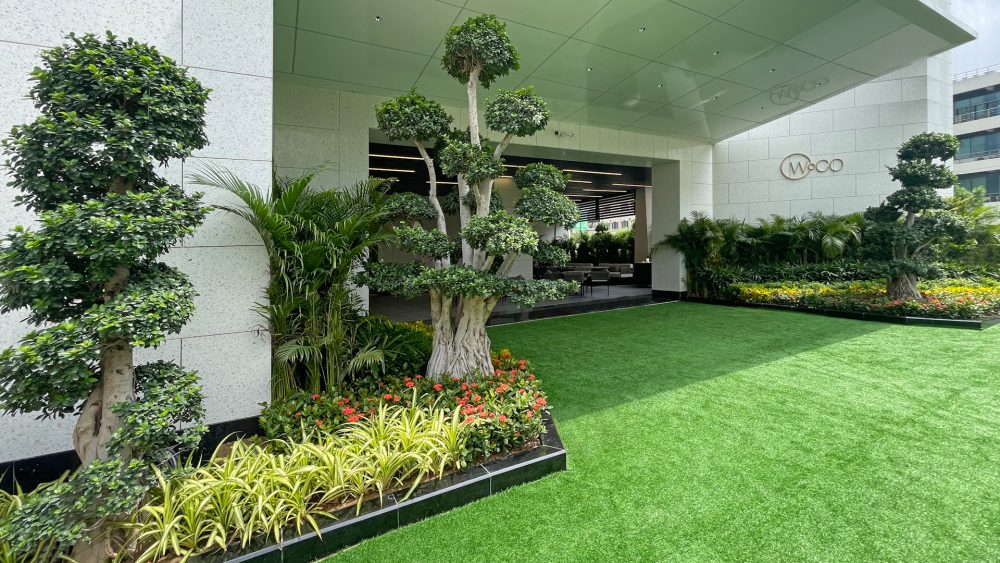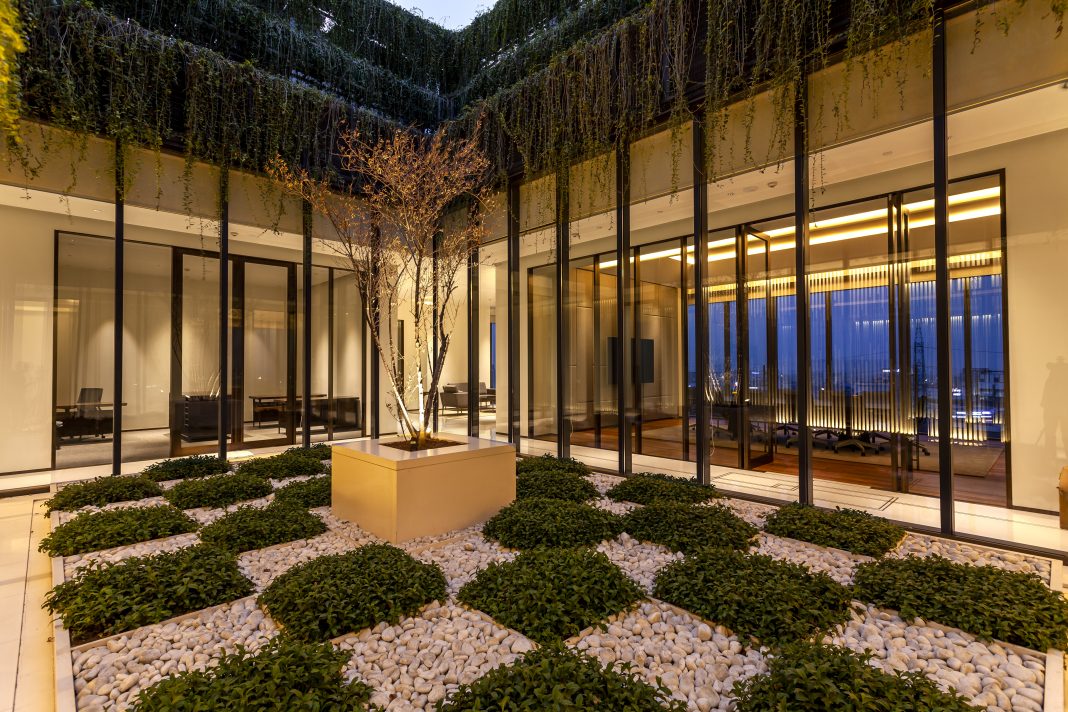Biophilic design takes root in India’s commercial spaces as told by five A&D experts.
India’s tech parks are booming—but at what cost? As glass towers rise and green cover shrinks, architects, interior designers and developers are turning to a powerful design philosophy that reconnects people with nature: biophilic design. From Bengaluru to Gurugram, a growing movement is reshaping commercial real estate to prioritize well-being, sustainability, and sensory connection. In this feature, five experts share how India’s workspaces are evolving from concrete boxes to living, breathing environments that support both performance and planet.
India’s Workspaces Need Trees, Not Just Towers
By Nithin Hosabettu | Design Director | IMK Architects

India’s rapid urbanisation is reshaping its cities, with tech parks emerging as symbols of economic progress—yet this transformation comes at the cost of lost green spaces and an increasingly inhospitable urban environment. While these hubs drive business and innovation, they also intensify the urban heat island effect, reduce green cover, and put immense pressure on infrastructure. The growing disconnect between built environments and nature has critically disrupted sustainability and human well-being. In response, architects and urban designers are rethinking tech parks, integrating biophilic principles to create healthier, more engaging workspaces.
Biophilic design is a necessary shift in workplace architecture, creating healthier and more natural work environments. Integrating open-air work zones, sky gardens, shaded courtyards, and green walls helps regulate temperature while promoting social interaction and spatial comfort. Thoughtful use of natural materials, large windows for ample daylight, and passive cooling techniques reduce dependence on artificial lighting and air conditioning, making work environments more energy-efficient and inviting. By embedding nature into the very structure of these developments, architects are shaping spaces that encourage a deeper connection to the environment, benefiting both individuals and the broader urban fabric.
Despite its clear advantages, biophilic design has yet to become the norm in India’s office space sector. While some pioneering projects highlight its potential, wider adoption requires a shift in urban development priorities. The evolution of workplaces requires a synergy between technological advancement and ecological stewardship, ensuring urban growth aligns with environmental sustainability. By integrating nature into urban environments, office spaces can evolve into functional, restorative settings that contribute to a more sustainable and resilient cityscape.
WoCO One: Designing Tomorrow’s Tech Park with Nature at the Core
By Anand Sharma & Goonmeet Singh Chauhan | Design Forum International

Can biophilic design in tech parks and commercial workspaces offer a sustainable counterbalance?
Is India’s real estate sector truly embracing this shift, or is biophilic design still an exception rather than the norm?
India is amidst massive urban development, driving multi-dimensional growth across all real estate segments, especially offices & IT Parks. The surge in tech parks boosts international trade and attracts global interest. However, this progress comes at the cost of collateral impact.
Rapid urbanisation leads to a steady increase in commercial development, transforming cities into dense concrete jungles. Combined with the depletion of green cover, this fundamental shift in planning and large-scale employment highlights the need to adopt open-air work zones to reduce energy consumption and fully embrace sustainable technologies. These changes are shaping not only our urban landscapes but also the way we work. The new-age planning must challenge the conventional workplace’s time-tested but worn-down approaches. They must move beyond the prosaic requirements, such as efficiently ventilated interior spaces or optimally-lit workspaces. They must care for the individual’s well-being by including informal spaces or planning the interiors with sufficient greens.
Biophilic workplaces—the spaces that integrate green patches into the core plan—have been shown to improve employee well-being, reduce energy consumption, and reduce the ecological footprint of commercial real estate. But is India’s real estate sector truly embracing this shift, or is biophilic design still an exception and not the norm? Nature-first tech parks can pave the way for a more liveable urban future.

Sitting in a commercially-packed locality of Udhyog Vihar, Gurugram, WoCO One is an example of a modern-day workspace. WoCO (World of Cool Offices) introduces a fresh perspective on workplace planning by aligning with the aspirations of an evolving workforce. Located in a verdant, commercially thriving neighbourhood near the NH-8 intersection in Gurugram, WoCO One reimagines workplace design through inclusivity, flexibility, and sustainability. Passive design principles are integral to its sustainability-driven ideology.
Spread over five acres and across nine floors, the WoCO One integrates passive design strategies to optimise energy efficiency and environmental sustainability. Vertical fins along the southwest façade act as shading devices, filtering harsh sunlight while allowing natural ventilation and reducing reliance on artificial cooling. Trellis-guarded projections enhance airflow, creating comfortable outdoor spaces that seamlessly blend with the interiors. The insulated glass envelope fosters a strong connection to the outdoors while maximising daylight without excessive heat gain, significantly reducing glare. These strategies contribute to a 32% reduction in the LPD Index, minimising energy consumption.
The design prioritises spatial fluidity, fostering collaboration and adaptability while embedding biophilic elements to enhance well-being. Landscaped terraces, open-air lounges, and green courtyards punctuate the built environment, reinforcing a seamless dialogue between architecture and nature. The integration of rainwater harvesting and recirculation ensures water sustainability, aligning with the broader goal of reducing the building’s ecological footprint. By weaving together passive design principles, energy-efficient systems, and a human-centric approach, the project redefines the contemporary workspace as an immersive, sustainable, and responsive urban environment.

The design solution for WoCo One crafts an all-encompassing workspace campus that walks in tandem with the requirements of the modern-day, while also mitigating the urban heat island effect through passive sustainability. The project champions a design approach that not only meets the evolving demands of modern workspaces but also actively addresses the global climate crisis. They offer innovative solutions to the challenges of conventional office planning while remaining highly responsive to environmental concerns.
Redefining Urban Workspaces: Human-Centric Design for a Healthier City Future
By Akshat Bhatt | Principal Architect | Architecture Discipline
Currently, 70% of humanity lives within 100 km of cities, and by 2035, this number will rise to 75%. Indian cities are rapidly evolving to house high-density commercial hubs, and the impact of urban consumption patterns on the environment and human well-being cannot be ignored. Adopting ways of building that are in tune with climate and context is crucial to mitigating these effects.

A responsible workspace serves the present while anticipating the future. High-performance materials, innovative energy-efficient systems, and biophilic elements create an environment that minimises impact and maximises comfort. Open-air work zones, sky gardens, passive cooling systems, and water-sensitive planning are some interventions that enhance employee well-being and reduce energy consumption, shrinking the environmental footprint of modern commercial hubs.
Cities can only reach their true potential if they become healthier places to live. We are still at the threshold of what can be achieved. Access to nature, well-balanced acoustics in interior spaces, and intuitive layouts can create an environment where people feel motivated and engaged. Design must leverage the tools of natural light, space, and materiality to enhance productivity and sustainability. Proactive steps are needed to redefine commercial real estate with a nature-first approach, ensuring that cities remain livable and resilient for future generations.
Biophilic Design: A Sustainable Counterbalance in Tech Parks and Workspaces
By Vishal Sharma | Founder Partner & Principal Architect | Confluence

The rise of tech parks in India’s urban hubs has transformed cities into dense concrete landscapes, driving economic growth but also contributing to heat islands and straining urban infrastructure. Amid this challenge, biophilic design offers a promising counterbalance by integrating natural elements into commercial workspaces. At Confluence, we have been practising this approach throughout our projects across typologies and not just as an aesthetic choice but as a fundamental shift in design and planning that can redefine the impact of large-scale developments on our cities.
We’ve seen how biophilic elements can transform the work environment in commercial spaces. For instance, in our project, Gulshan Experience Centre in Noida, water features meander through interiors, their gentle ripples reflecting light and creating a sense of tranquillity. Additionally, the incorporation of indoor hydroponic farming not only provides fresh produce but also highlights the design possibilities in commercial interior spaces. A careful selection of plants and vegetation is strategically placed, improving air quality, reducing stress, and fostering a deeper connection with nature. This is especially helpful in workplaces because they have direct correlations with the productivity levels of the occupants. In another project, the Gaur Manhattan Experience Centre in Ghaziabad, we drew design inspiration from nature’s fluidity, with curves that mirror the gentle flow of water over rocks and the delicate filtering of light through tree foliage, creating an organic aesthetic that complemented the urban sophistication required for the project. Vertical metal louvres, arranged in a continuous wave, merge the structure with a natural flow while pin lighting creates interest and mimics nature by creating the illusion of a night sky.
These design strategies are aligned with the principles of phenomenology in architecture, creating immersive environments that engage all senses, paying attention to how the user is expected to feel when experiencing a space. From open-air work zones and sky gardens to passive cooling strategies and water-sensitive urban design, biophilic elements in tech parks can significantly improve employee well-being, reduce energy consumption, and mitigate the ecological footprint of commercial real estate.
As architects, our role is to champion this nature-first approach, paving the way for livable, sustainable cities that balance economic growth with ecological responsibility.
Beyond Green Aesthetics: Why Biophilic Design Is Essential for Sustainable Urban Growth
By Raghuveer Veeramachaneni | Promoter and Managing Director | Vista Spaces

With the rapid rise of tech parks in India’s urban hubs like Bangalore, Hyderabad, Pune, Chennai and Delhi-NCR, our cities are transforming into dense concrete landscapes. While these commercial developments drive economic growth, they also accelerate heat islands, reduce green cover, and put immense pressure on urban infrastructure. Amid this urban sprawl, can biophilic design in tech parks and commercial workspaces offer a sustainable counterbalance?
Is India’s real estate sector truly embracing this shift, or is biophilic design still an exception rather than the norm?
Exploring whether nature-first tech parks can pave the way for a more livable urban future.
The number of full-glass buildings in our urban centres resonates with the fact that biophilic design is still an exception rather than a norm. However, the industry is evolving to understand better the benefits of biophilic design for all stakeholders – companies, employees, citizens, local neighbourhoods and governments.
Biophilic design is only one aspect of future-proof workspaces. A truly sustainable workspace should have a people-centric approach that puts the well-being of not only people who work in the building but also people who work or live around the building at the centre of the development. Green buildings offer numerous benefits for companies, employees, and the environment. By incorporating eco-friendly design and materials, green buildings:
- Reduce operational costs through energy and water efficiency.
- Boost employee well-being, productivity, and happiness through natural light, clean air, and a healthier work environment.
- Promote sustainability and reduce the company’s carbon footprint.
- Foster a positive and responsible corporate image.
As concern for climate change grows, the adoption of green building designs is expected to increase. Sustainable workspaces create a win-win situation for companies and employees. Although initial green upgrades may cost, they ultimately pay off through lower energy use, happier staff, and a strong brand image, leading to long-term gains. As more companies prioritise environmental responsibility, sustainable workspaces will become the standard, driving positive change for businesses, employees, and the environment.
Building Cities That Breathe

As India’s commercial sector pushes forward, the call for healthier, human-centric work environments is louder than ever. Biophilic design offers a proven path—one that doesn’t just reduce emissions or save energy, but revives how people experience space. From sky gardens to shaded courtyards, from fresh air to fresh perspectives, these five leaders show that the future of work is not only about tech—it’s about touch, texture, and the timeless wisdom of nature.


